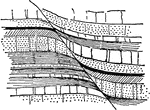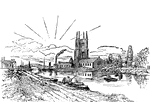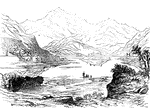
Diving Dress
"The diving dress envelops the whole body of the diver, the upper portion a being the "helmet," the…
Gunpowder Mill
"A sectional elevation of incorporating mill, showing one runner and ploughs (p, p); C, curb of bed;…

Gunpowder Mill
"A sectional elevation of incorporating mill, showing one runner and ploughs (p, p); C, curb of bed;…

Pursing Block
A block used in hauling in the pursing line or bridle of a purseseine. Two of these attached o the purse-davit…
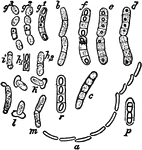
Bacillus Megaterium
"a, a chain of motile rodlets still growing and dividing (bacilli). b, a pair of bacilli actively growing…

Pyramid Pruning
"a shows a young tree with its second year's growth, the upright shoot of the maiden tree having been…
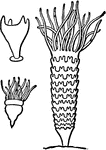
Aurelia
"Development of Aurelia. Above to the left, young scyphistoma with four perradial tentacles. Below to…

Siphonophora
"Diagram showing possible modifications of medusiform and hydriform persons of a colony of Siphonophora.…

Roach Scale Arrangement
"Arrangement of scales in the Roach (Leuciscus rutilus). L, Lateral line; t r, transverse line; a, transverse…
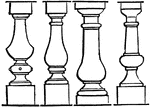
Baluster
"Popularly, banister or ballaster, the name given to small shafts or pillars set in a line at short…
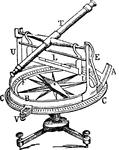
Declinometer
"Upon a tripod provided with levelling screws stands the pillar P, to which is fixed the graduated azimuthal…
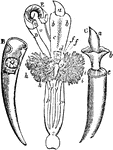
Dentalium
"Dentalium: B, the shell of Dentalium Entalis, broken longitudinally, showing the animal in a contracted…
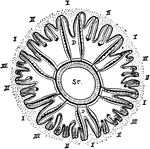
Cladocora
"Transverse section through a zooid of Cladocora. The corallum shaded with dots, the mesogloca represented…
Rope Clamp
A device consisting of a pair of clamping jaws carrying a ring and a hook. Used for securing or attaching…
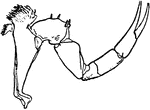
Limulus Polyphemus
"Third leg of Limulus polyphemus, showing the division of the fourth segment of the leg by a groove…

Limulus Polyphemus
"View of the ventral surface of the mid-line of the prosomatic region of Limulus polyphemus. The coxae…
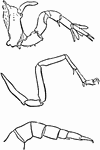
Prosomatic Limb
"Comparison of the sixth prosomatic limb of a recent scorpion (B), of Palaeophonus (C), and of Limulus…

Garypus Litoralis
"Garypus litoralis, one of the Pseudoscorpiones. Ventral view. I to VI, Prosomatic appendages. o, Sterno-coxal…

Cryptostemma Karschii
"Cryptostemma Karschii, anterior aspect of the prosoma with the "hood" removed. I to IV, first to fourth…

Cryptostemma Karschii
"Cryptostemma Karschii, one of the Podogona. Vental view. I to VI, The six pairs of appendages of the…
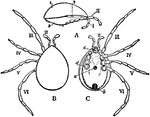
Holothyrus Nitidissimus
"Holothyrus nitidissimus, one of the Acari; ater Thorell. A, Lateral view with appendages III to VI…

Semicircular Arch
"Semicircular arch, he center of which is in the same line with its springers." — The Encyclopedia…

Flat Arch
"Flat arch, where the soffit is horizontal and sometimes slightly cambered (dotted line)." — The…
Bacillus Megaterium
"A rodlet segmented in four, each segment containing one ripe spore." — The Encyclopedia Britannica,…

Bee Abdomen
"Abdominal Plate (worker of Apis), under side, third segment. W, wax-yielding surface, covering true…
Water Level
"a, a, a, represents the water-level of a pond or reservoir upon elevated ground. From this pond a line…
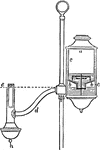
Reading Lamp
"An example of a form of reading lamp is seen here. The lamp is mounted on a standard on which it can…

Hide Divisions
"The hides now come to be trimmed and prepared for tanning in the shape in which they are intended ultimately…
Ruling Pen
A form of pen used for drawing lines of even thickness. It commonly consists of two blades which hold…
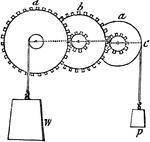
System of Wheels
"System of Wheels.—As the wheel and axle is only a modification of the simple lever, so a system…

Water Pressure
"Suppose a number of vessels, of different shapes and sizes to have a communication between them, by…

Intermitting Spring
"A mountain and spring, showing how the principle of the syphon operates to produce the effect described.…
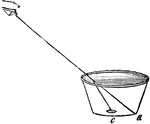
Cup and Shilling
"The refraction of water is beautifully proved by the following simple experiment. Place an empty cup,…
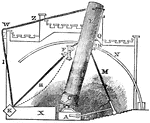
Telescope
"The following description of a section of Lord Rosse's telescope, though not so perfect as could be…
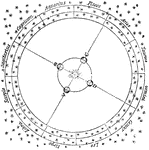
Zodiac Signs
"The twelve signs of the zodiac, together with the Sun, and the Earth revolving around him. When the…
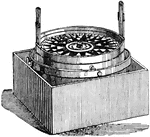
Azimuth Compass
A compass placed in some convenient part of a ship on the midship line and provided with vanes, screws,…
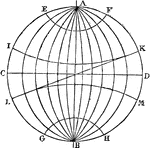
Earth Divisions
"The Earth, whose diameter is 7,912 miles, is represented by the globe, or sphere. The straight line…
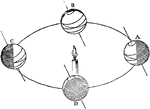
Earth Axis
"Now it is the inclination of the Earth's axis, as above described, which causes the lengths of the…

Earth Axis
"Now it is the inclination of the Earth's axis, as above described, which causes the lengths of the…

Skeletal Trunk
"The skeleton of the trunk and the limb arches seen from the front. C, clavicle; S, scapula; Oc, innominate…

Nerve Roots
"The spinal cord and nerve-roots. A, a small portion of the cord seen from the ventral side; B, the…
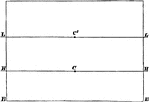
Horizontal Line Diagram
In this figure BB is the base line; HH the common horizontal or vanishing line; C…
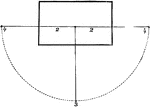
Parallel Perspective
This figure represents the whole of the points and lines requisite for working out a drawing in "parallel…
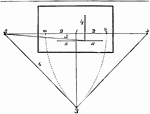
Angular Perspective
This figure comprises the whole of the points and lines preparatory to beginning a drawing in "angular…
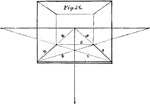
Parallel Perspective
The perspective shown in this plate is parallel perspective; and the subject here intended to be represented…

Angular Perspective
The perspective in this plate is "angular perspective," and the figure it represents is a flat square…
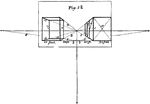
Parallel Perspective
Two upright oblong figures are here represented in parallel perspective. They may be imagined to resemble…

Angular Perspective
This object is a cube, having therefore all its faces of equal dimensions; and as both sides recede,…

Angular Perspective
This cube has four additional cubes of equal dimensions. This is effected by first drawing the cube…

Angular Perspective
This figure differs from the others because they are solid cubes. Further, the geometrical scale is…
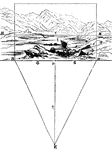
Distance
"A landscape is supposed to be viewed from the spot marked E; and that the spectator is desirous of…

Vertical Line
That an accurate notion of the vertical line may be obtained, the plane of the picture must be supposed…
